By Victor Bozarth for PCGS ……
In the first installment of this three-part series on collecting the coinage of the Carson City (CC) Mint, I covered the three smaller silver denominations produced by that famous mint in Nevada, including dimes, quarters, and half dollars.
Here in part two, I turn to the “cartwheels” – silver dollars, that is. These include the Liberty Seated, Trade, and Morgan Dollars. The first Liberty Seated Dollar rolled out of the Carson City Mint in 1870, with the last rolling out in 1873 when the first Trade Dollar was produced there. That series continued at the Carson City Mint until 1878, when the first of many “CC” Morgan Dollars were struck. Silver Dollars were produced at Carson City from 1870 to 1885 and then again from 1890 to 1893, when the Mint closed.
Crazy for CC Cartwheels
When you mention Carson City to a numismatist, many might first think of General Services Administration (GSA) Carson City Morgans. And why not? Two major factors thrust Carson City dollars into the public eye in the 1960s and ‘70s. Collectors’ appetites were whetted during the great silver dollar bag rush of the late ‘50s and early ‘60s when thousands of bags of silver dollars were dispersed to the public at $1,000 face value during this time.
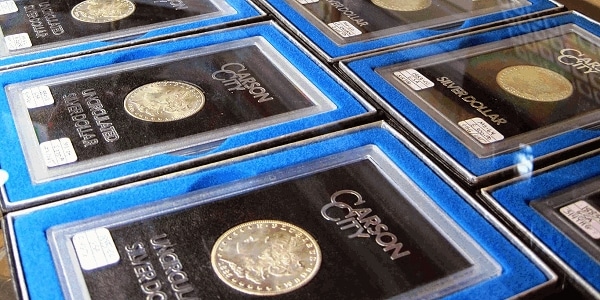
In addition to the incredible dispersal of thousands of silver dollar bags (mostly between 1961 and ’64) during the silver dollar bag rush, the removal of silver from most of our coinage in 1965 spurred demand for all forms of silver. While the silver dollar bag rush was instrumental in laying the foundation for many more silver dollar collectors, much of the mystique and allure surrounding Carson City dollars involves the incredible GSA Hoard of mostly CC Morgan Dollars. This massive GSA holding was dispersed in seven sales between 1972 and 1980.
One of the fascinating aspects behind dollars produced at Carson City is the evolution of design types, from the Liberty Seated Dollar to the Trade Dollar and then in 1878 to the Morgan Dollar. Early mintage quantities were quite small, but by 1878 the Carson City Mint had produced three different dollar designs. Sure, CC Morgan Dollars are really cool, but there’s so much more to the early CC Liberty Seated and Trade Dollar series that many never investigate. The fascination with Carson City Morgan Dollars fuels incredible demand, but their “older siblings” are often overlooked.
While I will discuss CC Morgans a little later, let’s take a closer look at the two early CC silver dollar designs.
Liberty Seated Dollars Take a Stand
Silver dollar coinage bearing the Liberty Seated design of Christian Gobrecht had been in production as early as 1836, but in 1840 it was being churned out in much larger numbers. The vast majority of Liberty Seated Dollars were produced at the Philadelphia Mint, but branch-mint issues include four dates each from the New Orleans, San Francisco, and Carson City Mints.
The total mintages for the four mints, including Philadelphia, are listed below:
- Philadelphia – 5,465,465
- Carson City – 19,288
- New Orleans – 974,000
- San Francisco – 29,700
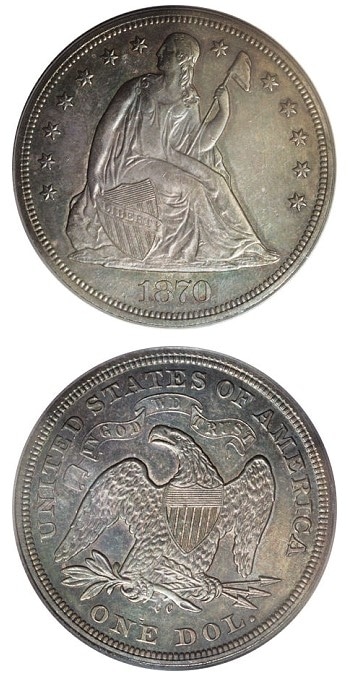 These figures include only business strikes and do not account for the few hundred specimens often categorized as “Gobrecht” Dollars, which were made from 1836 through 1839.
These figures include only business strikes and do not account for the few hundred specimens often categorized as “Gobrecht” Dollars, which were made from 1836 through 1839.
While there were nearly a million Liberty Seated Dollars produced in New Orleans (mostly in 1859 and 1860), the total number produced in both San Francisco and Carson City seems like more of an experiment than a practical exercise. Production of silver dollars at the CC Mint would increase significantly going forward with the Trade and Morgan Dollar designs. In fact, in just the first year of the Trade Dollar in 1873, there were 124,500 strikes minted at Carson City–a whopping six times more than the total number of CC Liberty Seated Dollars.
All four of the CC Liberty Seated Dollar issues are scarce. The series was produced at CC from only 1870 to 1873. A total of only 19,288 total Seated Dollars were produced at CC with the individual mintages of only 12,462, 1,376, 3,150, and 2,300 pieces, respectively. While all of these dates are challenging, they are all available in circulated grades. There are only a handful of Mint State examples for any of the four dates.
Mintages of Liberty Seated Dollars produced at Carson City are quite indicative of the number of varieties. Indeed, the 1870-CC first-year-of-issue with a mintage of 12,462 is the only date with more than one die variety for the date. There are nine die varieties for 1870-CC while the three remaining lower mintage dates have only one each. Liberty Seated Dollar varieties are classified by their OC number, a reference to last initials of Dick Osburn and Brian Cushing, who wrote A Register of Liberty Seated Dollar Varieties, which breaks down die varieties for all dates of Liberty Seated Dollars – including the four Carson City issues.
Two significant examples sold in the Heritage Auctions Sierra Biker event held in conjunction with the American Numismatic Association’s World’s Fair of Money in August 2021. Examples of both the 1870-CC and 1872-CC Liberty Seated Dollars in Mint State enjoyed strong bidding. And no wonder. With PCGS populations of just eight (and eight better) and three (with only one better), respectively, these two dates represent coins desired by both Carson City collectors and advanced Liberty Seated Dollar collectors. Not only would a collector putting together a high-end CC type set need one of these coins but any collector pursuing either CC Liberty Seated Dollars or the entire set would also need these pieces.
A fabulous – albeit challenging and expensive – date set of Carson City Liberty Dollars would be noteworthy in all grades! Most likely the type collector will pursue the 1870-CC, but don’t pass on any of the four dates if you like the coin. Regardless, CC Liberty Seated Dollars will always be in demand.
Trade Dollars Take the Stage
As production of the Liberty Seated Dollar ended in Carson City in 1873, production of the new Trade Dollar began.
Trade Dollars were produced to circulate in Asia and compete with other dollar-sized silver coins from other countries. Indeed, trade concerns were the reason for the production of the Trade Dollar. In Asia, Mexican Pesos (eight reales) were preferred to our Liberty Seated Dollars because the Seated’s silver content was less than that of the Mexican Peso. In fact, American businessmen often imported these Mexican Pesos at a 7.5% premium over their bullion value to facilitate trade with Asia versus using Liberty Seated Dollars.
The end of Liberty Seated Dollar production and the beginning of Trade Dollar production was in many ways a knee-jerk reaction to international bullion markets and United States mining interests. The international market for silver dropped precipitously in the early 1870s. Up until this time, mining interests were able to sell their silver in other parts of the world including Europe, Latin America, and Canada. But, most importantly, up until the Coinage Act of 1873 mining interests were able to deposit silver with the U.S. Mint for conversion into silver coins, for which it could then be exchanged.
Although the amount of silver contained in U.S. minor coinage was reduced in 1853, the composition of Liberty Seated silver dollars wasn’t changed. Because the amount of silver wasn’t reduced in the dollars, the coinage denomination requested for virtually all this deposited silver was Liberty Seated Dollars. When over a million Seated Liberty Dollars were produced in both 1871 and 1872, silver dollar production was suspended by the Coinage Act of 1873. The new set of 1873 coin laws not only ended production of the Liberty Seated Dollar, but also the two cent, the three cent silver, and the half dime denominations.
While Liberty Seated Dollars were eliminated with the Coinage Act, the production of Trade Dollars was approved in this same act. In addition, the amount of silver in minor coins was reduced once again, while the amount of silver in Trade Dollars was set at 420 grains of .900 fine silver. During this time the bullion value of Trade Dollars was roughly $1.02. Trade Dollars were authorized to facilitate trade with Asian markets, but probably most importantly to satisfy immensely powerful Western mining interests. While the Coinage Act of 1873 took the deposit of silver away, production of the Trade Dollar opened another market for that same silver.
Trade Dollars were originally legal tender in the U.S., but transactions were limited to only $5. Most of the early mintages went to Asia, but by the 1875 and 1876 much of the production was being used in the states. When silver markets fell further in 1876 and millions of Trade Dollars began returning from China, the United States Congress demonetized all Trade Dollars. This is the first and only coin demonetized by our government, but in 1887 the public was able to redeem them at face value once again.
While Trade Dollars were struck through 1885, production of Trade Dollars at Carson City ended in 1878 once the Morgan Dollar series began. The demise of the Trade Dollar was made official with the Sherman Silver Act of 1878. No business-strike Trade Dollars were produced at any U.S. branch mints (including Carson City) after 1878. Proof Trade Dollars were produced from 1879 to 1885, but the last two years of issue constitute a story of their own.

The 1884 and 1885 issues were produced clandestinely and only 10 and five examples are known of each, respectively. The issues struck from 1879 through 1883 were produced in Philadelphia, with recorded mintages of between 960 and 1,987 pieces. The famous 1884 and 1885 Proofs were unknown until notable collector John W. Haseltine announced he had found them in 1884 and 1885 Proof Sets from his father-in-law, another famous collector named William Idler. Idler was known to have close contacts with Mint personnel.
Trade Dollars were produced at Carson City for six years, from 1873 to 1878. There were 4,211,400 Trade Dollars produced at Carson City, which was a tremendous increase in production. Curiously in just the first year (1873) of Carson City Trade Dollar production, there were more than six times as many 1873-CC Trade Dollars minted as the entire four-year Liberty Seated Dollar production.
While mintages of Trade Dollars at Carson City were significantly larger than for CC Liberty Seated Dollars, depending on the grade, all dates can be challenging. The mintages for the six Trade Dollar dates (seven issues) are as follows:
- 1873-CC – 124,500
- 1874-CC – 1,373,200
- 1875-CC – 1,573,700
- 1875-S/CC – Mintage unknown
- 1876-CC – 509,000
- 1877-CC – 534,000
- 1878-CC – 97,000
Like their predecessor Liberty Seated Dollar design, the Carson City mintages of Trade Dollars are indicative of their relative availability. Of the total 4.2 million Trade Dollars produced at Carson City, over 70% were struck in 1874 and 1875. For the Carson City Trade Dollars, the first and last years of issue (1873 and 1878), are the two scarce lower-mintage dates, but the over-mint mark 1875-S/CC is scarce, too. There is also an 1876-CC Trade Dollar doubled die reverse variety that is quite popular with advanced date collectors.
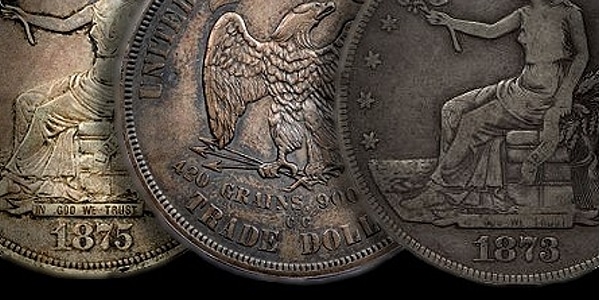
There are two different obverse and reverse variety designations for Trade Dollars. Obverse One was used on coins dated from 1873 to 1876 and is distinguished by these two features:
- The end of the scroll points to the left
- The extended hand has only three fingers
The Obverse Two design, which started sometime in 1876 and is used on all coins produced afterward, can be attributed by the following:
- The scroll ends pointing down
- There are four fingers on Miss Liberty’s extended hand
The Type One Reverse features a berry under the eagle’s left (viewer’s right) talon and the lower arrowhead ends over the “0” in “420”, while the Type Two Reverse has no berry under the talon and the arrowhead ends over the “2” in “420”. Curiously, both reverses were used in 1875 and 1876 with only the Type One Reverse used in 1873 and 1874 and the Type Two Reverse employed on all issues from 1877 and after.
Many Liberty Seated and Trade Dollars have been lost to circulation and/or bullion speculation. Additionally, many Trade Dollars were damaged due to “chop marks” counterstamped by mainly Chinese merchants onto many of the coins sent to Asia. The number of Trade Dollars that were chop marked also lowers the number of problem-free specimens available. Chop-marked Trade Dollars are graded, but those coins are specially labelled.
Indeed, checking PCGS populations for both Liberty Seated and Trade Dollars reveals just how scarce both the types – and particularly those from Carson City – really are! Below, I’ve listed total respective PCGS populations for all the Liberty Seated and Trade Dollars as compared with their total respective PCGS populations for all the Carson City Liberty Seated and Trade Dollars:
- All Liberty Seated Dollars: 12,488
- CC Liberty Seated Dollars: 482
- All Trade Dollars: 15,463
- CC Liberty Seated Dollars: 2,744
*Population figures current as of September 2021
King of the “CC”-oop: Morgan Dollars
Carson City Morgan Dollars are arguably the most popularly collected U.S. coin. Collectors, investors, and dealers all recognize how popular silver dollars are in the U.S. rare coin market. Add the mystique of the Comstock Lode, the Wild West, and the Carson City Mint to the mix and you have a proven winner.

With the blessing of the Bland-Allison Act, the U.S. Mint was authorized to produce two million silver dollars per month (in total at all branch mints) starting in 1878. Over 750 million were produced between 1878 and 1904, then again from 1921 to 1928, and once more in 1934 and 1935. While less than 5% of those dollars were made in Carson City, the combination of several factors has contributed to their success. Carson City Morgans enjoy both incredible demand and a sufficient supply.
Who doesn’t have a little treasure hunter in their DNA? One of the most fantastic silver finds in history – the Comstock Lode – was less than 25 miles from Carson City. Curiously despite this proximity to the Comstock Lode and numerous other silver mines, the Carson City Mint experienced silver shortages in every year of operation. Dollar planchets were not often available in large enough quantity at CC, which limited CC dollar mintages to less than that of the Philadelphia, the New Orleans, and the San Francisco Mints. Ironically, the majority of the silver mined in the Comstock Lode (and other area silver mines) was shipped to the three other mints producing silver dollars.
There are so many factors that have contributed to the popularity and overall demand for Carson City Morgan Dollars. Let’s talk about supply. How did so many Carson City Morgan Dollars survive? Let’s first look at the legislation that led to silver dollars being produced in such large quantity.
As we’ve already seen, the Coinage Act of 1873 ended production of the Liberty Seated Dollar, yet it also authorized the production of the Trade Dollar. The Sherman Silver Act of 1878 ended production of the Trade Dollar, but what led to the production of the Morgan Dollar? The Bland-Allison Act gave the Western mining interests the ultimate guppy, the United States Treasury.
One of the best explanations of the Bland-Allison Act is in a fabulous article “The Mystique of the CC Silver Dollar”, written by a well-known dealer William Spears and included in John Highfill’s Comprehensive U.S. Silver Dollar Encyclopedia:
“The Bland-Allison Act was the result of political manipulation by [W]estern silver mine owners to combat falling silver prices by making the mint into a captive market paying inflated subsidy prices for domestic silver. This price decline was due to foreign powers dumping thousands of tons of silver on the world market, combined with the discovery of enormous quantities of silver deposits in Nevada (the famed Comstock Lode was only one of many). The Act forced the United States Treasury to buy huge amounts of new domestic silver to be used exclusively for mintage into silver dollars, and it mandated that the four U.S. mints produce a minimum of two million silver dollars per month. The CC, Phil, and SF mints started production of Morgan silver dollars in 1878, and NO began in 1879.”
One of the biggest takes I get from this explanation is that the production of the Morgan Dollar was, to a large extent, the tail wagging the dog. We didn’t produce Morgan Dollars because we needed them for commerce, we produced Morgan Dollars because of politics! In typical boondoggle fashion, this overproduction of silver dollars continued through 1904. Ironically, this incredible production quota when added to the fact that silver dollars circulated poorly in most states were the underlying factors that laid the foundation for what became one of the most highly collected U.S. coins – the CC Morgan Dollar.
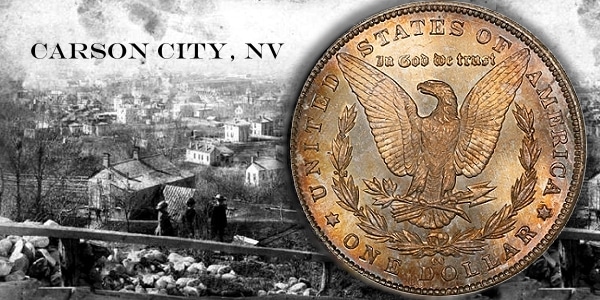
Dollars (including Carson City Morgans) have arguably been one the most popularly collected U.S. coins for the last 50 years. Carson City Morgan Dollars have two basic design types. From 1878-80 the Carson City Mint produced the Morgan with a flat breast eagle reverse. In 1880, the reverse design was changed to a rounded breast eagle, making two basic design types for 1880. There are 15 different dates included in the Carson City Morgan Dollar set if you include the 1900-O/CC. There are scarce dates in this series, but all dates are available in all grades up to MS65.
Many advanced Carson City Morgan collectors also include the 1879-CC Capped Die variety as well as many of the 1880 date position varieties. There are numerous VAM die varieties for each date including the 1890-CC Tailbar that many collectors include in their sets. Some specialized Carson City collectors pursue only the VAM die varieties for a particular date. For example, there are 29 VAM varieties for 1878-CC Morgans OR 12 VAM die varieties for the 1900-O/CC. The difficulty factor is up to you.
I’ve seen numerous permutations and combinations of collector sets over the decades. Indeed, dealers and telemarketers have both sold Carson City Morgan starter sets for years. Most often these starter sets are comprised of the three most common of the CC Morgans: the core dates of 1882, 1883, and 1884. Interestingly, while I have seen circulated three-piece sets of these dates, they are almost always marketed in uncirculated grades. Why? The average grade of many Carson City dates is uncirculated!
This “average grade” consideration is important.
Many collectors don’t realize that the demand for a particular item often comes down to whether a dealer has a customer for it or not. The spread in price between grades for each date is a function of supply and demand. One of the most effective ways a collector can maximize their upside is to buy the spread. This “buy the spread” philosophy also applies to other U.S. coins.
The more common Carson City dates are available in quantity up to and including MS65. Higher-grade coins jump in price often incrementally from MS65 to MS66 with even larger spreads between MS66 and MS67. If your goal is “finest known”, then that’s great. You should go for it.
On a practical basis, I believe buying coins in a grade before the larger jump in price is a sound strategy. Not only does this strategy allow you to buy more coins, but these coins with spreads are always desirable. For example, my “buy the spread” philosophy on 1883-CC would be to pursue coins in MS65 or better that have a large (almost incremental) price spread to the next grade.
Mintages for Carson City Morgans are interesting but quite deceptive. Once again, many CC dollars never made it to circulation, resulting in an average grade of mid-range uncirculated or better for many dates. For decades, the 1881-CC and 1885-CC with the two lowest Carson City Morgan mintages of only 296,000 and 228,000, respectively, have been nearly as valuable in circulated condition as they are in MS63. Often telemarketers touted these low mintages as a sales pitch. These dates are a paradox because despite them being the two lowest-mintage dates in the entire series, they’re always available up to MS64 depending only on the current market price. Entire bags were saved!
The key Carson City dates include the 1879-CC, the 1889-CC, and the 1893-CC. The 1878-CC, 1880-CC, 1890-CC, 1891-CC, 1892-CC, and 1900-O/CC are all better dates too versus the more common 1881-1885-CC dates. Many of these dates especially the 1879-CC, 1889-CC, and 1893-CC are expensive and difficult to locate in lofty grades. To lend some perspective to the availability of Carson City Morgans, I’ve listed the original mintages as compared to the MS63, MS65, and MS67 populations for all 15 CC dates in the series.
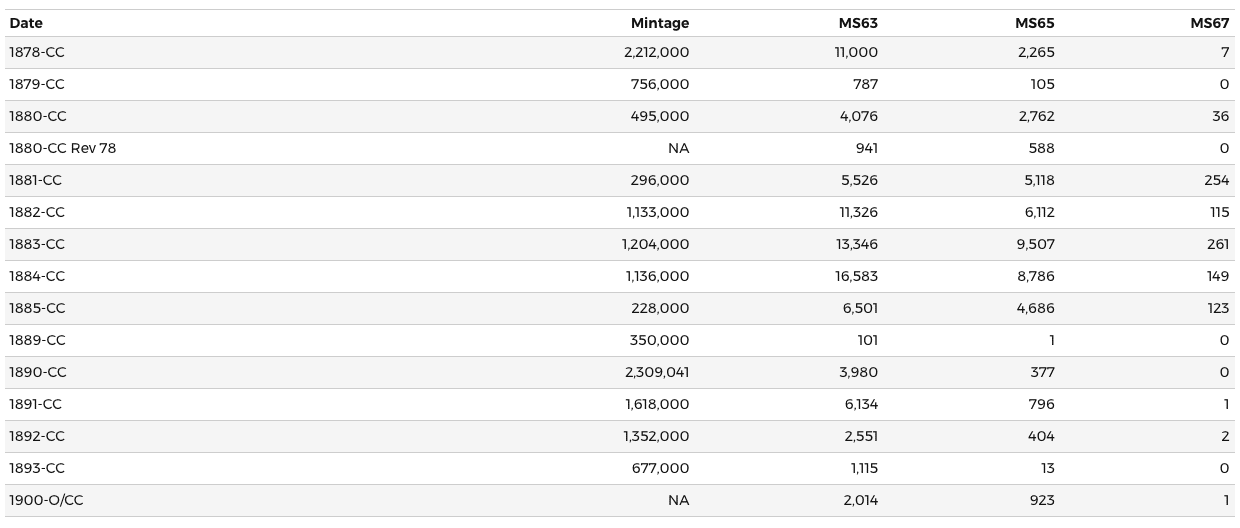
Total Carson City Morgan Mintage: 13,862,041
*Population figures current as of September 2021
What seems clear from PCGS population figures is the fact that a set of Carson City Morgan Dollars in MS63 is a worthy project that can be completed. Having helped numerous customers build CC dollar sets over the years, many collectors have opted to mix in higher grades based on a price point. In other words, their sets most often included higher-grade coins based on price and availability. The wonderful opportunity for Carson City Dollar collectors is that higher grade coins do exist for many of the 15 dates.
Interestingly, the GSA Hoard included nearly three million (mostly uncirculated Carson City Morgan Dollars) coins out of the original mintage of just under 14 million Carson City Morgans. In the early 1970s, this gigantic GSA Hoard was dispersed in seven different auctions beginning in 1972. The first distribution of coins focused on the three most-common dates (1882-CC, 1883-CC, and 1884-CC) discussed above and offered at $30 each. In this first auction more than 800,000 coins were sold, but they didn’t sell out.
Between this first sale in 1972 and the final sale in 1980, the entire 2.9 million GSA Dollar Hoard was dispersed. More than $100 million from these sales was funneled into government coffers. Both dealers and collectors were offered an extraordinary opportunity to buy many of these GSA dollars at a fraction of what they are worth today. In hindsight, these GSA sales were foundational in the incredible supply of Carson City dollars. Demand for these coins, aided earlier by the silver dollar bag rush and the overall rush for silver bullion itself, has never waned.
Carson City coinage has it all. Whether you’re interested in Carson City cartwheels or a scarce CC Liberty Seated Liberty issue, there’s something for everyone. You can start slowly or jump in with both feet. That is the beauty of collecting – it’s all up to you!
* * *


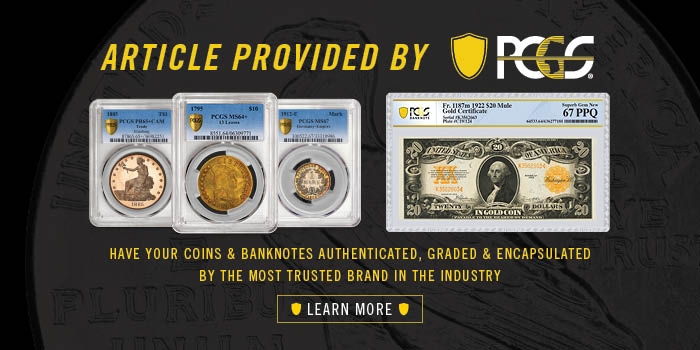



What’s the value of an 1881 cc 480 grains 900 fine trade dollar ?